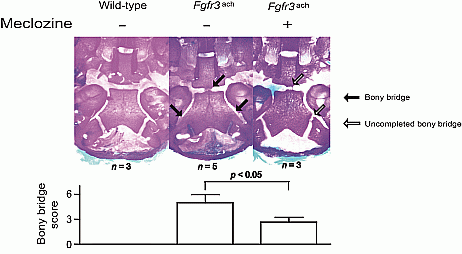ICCBH2015 Oral Communications (1) (22 abstracts)
Meclozine has a potential effects on short stature and foramen magnum stenosis in transgenic mice with achondroplasia
Masaki Matsushita 1 , Hiroshi Kitoh 1 , Kenichi Mishima 1 , Hiroshi Sugiura 1 , Sachi Hasegawa 1 , Akiko Kitamura 1 , Naoki Ishiguro 1 & Kinji Ohno 2
1Department of Orthopaedic Surgery, Nagoya University School of Medicine, Nagoya, Japan; 2Division of Neurogenetics, Nagoya University School of Medicine, Nagoya, Japan.
ACH (achondroplasia) is one of the most common skeletal dysplasias with severe short stature caused by gain-of-function mutations in the FGFR3 gene. Foramen magnum stenosis is a serious neurological complication of ACH. Downregulation of the FGFR3 signaling is a radical therapeutic strategy for the disease. We previously demonstrated that meclozine, an over-the-counter drug for motion sickness, inhibited elevated FGFR3 signaling in chondrocytic cell lines. In the present study, we investigated the effects of meclozine on longitudinal bone growth and foramen magnum stenosis in transgenic ACH mice.
We used transgenic mice carrying the heterozygous Fgfr3ach transgene. Food containing meclozine (0.4 g/kg) was administered to growing Fgfr3ach mice for three weeks and analyzed by micro-computed tomography scans. The bone length and the area of foramen magnum were calculated using reconstructed 3D images. For histological evaluation of the cranial base in newborn infants, the meclozine food was administrated to pregnant mice carrying Fgfr3ach embryos after 14 days of gestation. Complete and uncompleted bony bridges of the spheno-occiping synchondrosis and anterior intraoccipital synchondrosis were scored at two and one points, respectively.
The bone lengths including the radius, ulna, femur, tibia, and vertebrae (L1-5) in the meclozine-treated Fgfr3ach mice were significantly longer than those in the untreated Fgfr3ach mice. Foramen magnum areas, however, showed no significantly differences between the mutant mice with and without meclozine treatment. The bony bridges of synchondroses around foramen magnum were commonly found in Fgfr3ach mice at postnatal 5 days without treatment, but meclozine significantly decreased the bony bridge score (Figure).
Meclozine promoted longitudinal bone growth in growing Fgfr3ach mice. Maternal administration of meclozine could prevent premature closure of synchondroses around foramen magnum in Fgfr3ach mice.
Disclosure: The authors declared no competing interests.

Figure 1
 }
}



